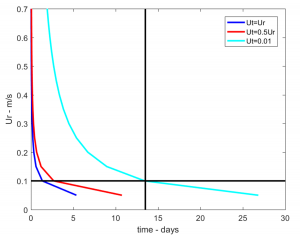Doi.org/10.1016/j.ecss.2012.02.013
Target Article
Andutta, F., Kingsford, M.J., and Wolanski, E., (2012). ‘Sticky water’ enables the retention of larvae in a reef mosaic. Estuarine, Coastal and Shelf Science, 101, 54-63 Available at: http://www.sciencedirect.com/science/article/pii/S027277141200039X DOI: 10.1016/j.ecss.2012.02.013
Significant Claim and Possible caveat with this article
This paper claims to provide a simple analytical formulation that explains ~70% of the variation of larval retention in both calm and windy conditions over different reef clusters in the Great Barrier Reef (GBR) of Australia. The authors have used a calibrated numerical model and applied different scenarios of weather in order to assess larval retention in boxes (10 by 10 km) in many areas of the GBR. They proposed a formulation for predicting flushing time in reef clusters (Equations 1 and 2). However, here we are focusing on Eq. 1, which was claimed by the authors to be more accurate than Eq. 2. In Andutta et al (2012) Eq.1 is,
T = alpha / (UR UT), (1)
with UR 0 (residual current), UT 0 (maximum water speed in a tidal cycle), and alpha=1159. This equation was calibrated for a box size of 10 km, and the alpha has never been checked for other sizes (e.g. 9 Km, 11 Km, 11.5 Km, 12 Km.). In our view, a sensitivity analysis regarding this proposed approach to quantify passive larvae retention is required.
Our argument is that this proposed formulation may not be as accurate as they have claimed. It is observed that when considering Ur = 0.1 m/s and Ut = 0.01 m/s (negligible tidal currents), then the flushing time is about 13.4 days. However, if we drop Lagrangian particles inside the box (10 by 10 km), subject to a flow speed of 0.1 m/s, these particles would travel nearly 116 km after 13.4 days, which is a straightforward calculation (Eringen, 1980[1]). Therefore, the box is quite likely to be empty even before 10 days with Ur = 0.1 m/s and Ut = 0.01 m/s.
We do not dispute that both advection and dispersion contribute to reducing the flushing timescale, as suggested by the authors. A more detailed check should be carried out in the future regarding the sensitivity analysis of this formulation in new simulations using different box sizes and coefficient (alfa as they defined in Equation 1).
References
Comments
In WL-Letters you have the freedom to respond to any caveat that may be inaccurate.
-- Andutta (talk) 18:09, 6 July 2022 (UTC)
